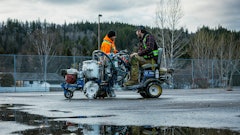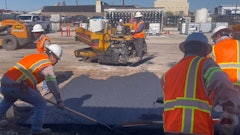As professionals in the industry, you’ll likely run into property managers who are looking to learn more about sealcoating or may have heard stories from others not as well informed. Below are common questions and answers surrounding the sealcoating industry that can help them when it comes to decision time.
What is sealcoating and what does sealcoating do?
Sealcoating extends the useful life of the capital asset—an asphalt parking lot—by protecting the pavement from the natural aging process caused by sunlight, water and debris. Sealcoat also protects pavement from degradation caused by leaking oil, gasoline and other caustic products. An added benefit is that sealcoating adds to the “curb appeal” of a paved surface, giving it a clean, uniform look.
There are two essential options for sealcoating: refined coal tar-based sealers and asphalt-based sealers.
Where does sealant come from?
Refined coal tar-based sealers are produced from selectively refined fractions of crude coke oven coal tar, which is a byproduct of the metallurgical coke-making process. Metallurgical coke is required to produce Basic Oxygen Furnace (BOF) steel. As coal is converted to coke in the coke oven, coal tar is generated as a byproduct, and this material is referred to as “crude coal tar”. Just like “crude oil”, crude coal tar serves as a raw material that is distilled into many different fractions in coal tar refineries. The different fractions are then used to make many different products, including refined coal tar-based sealers. Similarly, the asphalt used in asphalt-based sealers is one of the fractions that come out of petroleum refineries.
Are pavement sealers hazardous?
Air sampling studies showed refined tar-based sealers pose insignificant inhalation risk to applicators, manufacturers or the general public. Coal tar is listed by the US Food and Drug Administration (FDA) as “generally recognized as safe and effective” active ingredients for use to treat these skin ailments (dandruff, psoriasis, eczema) with coal tar concentrations up to five percent in over-the-counter products. In fact, millions of people worldwide use coal tar soaps, shampoos and creams approved for use as over-the-counter medicines. Research with insurance carriers shows a general lack of insurance claims over the history of sealant use.
Some activists say that refined tar-based sealers are a health threat, but generations of family-owned companies in the business of making or applying sealcoat have zero reports of adverse chronic health effects—including cancer—that can be attributed to exposure to sealcoat.
Many studies have been performed over nearly a century to see if patients who intentionally expose themselves to high level doses of coal tar for long periods of time have increased risk of cancer. All the studies have reached the same conclusion—there is no evidence of cancer.
What is the connection between coal tar and PAHs?
Activists point to the US Geological Survey (USGS) research to claim that sealants are the main source of polycyclic aromatic hydrocarbons (PAHs) in the environment. However, the USGS has been shown to have manipulated data and used circular reasoning in their sealant studies. Independent studies of New York Harbor and Puget Sound (Seattle) found sealant contributes less than 1% of PAHs to sediments in those locations. A recent independent statistical study of the Illinois River by the Universities of Illinois and Milwaukee-Wisconsin suggested a sealcoat contribution of no more than a few percent. The independent studies are consistent with industry-funded analyses.
PAHs occur naturally; they are all around us and always have been. PAHs are made whenever something organic is heated up or burned. Smoke from forest fires and wood burning fire places contains PAHs. Plants decaying in a swamp or a compost pile are making PAHs. Emissions from planes, trains and automobiles, cooking food, lubricating oils, volcanic eruptions – PAHs are in all those substances as well as in materials derived from coal tar. This means that PAHs are everywhere in our environment. PAHs have been around since the dawn of man. If there was a fire that offered our ancestors warmth or light, or cooked their food, PAHs were present.
Why can you sometimes smell sealcoat after it has been applied?
Refined tar-based sealer has a very distinct odor, and the human nose is able to detect it at extremely low concentrations. The smell is primarily the presence of naphthalene, which has an odor threshold about three parts per billion (ppb), a very low concentration. To put this into perspective, the odor threshold for nail polish remover is 7,000 ppb. The American Conference of Governmental Industrial Hygienists states that the level of naphthalene that is considered safe for workers is ten thousand ppb. Therefore, the difference between being able to smell it and worrying about it is huge.
Air sampling studies showed refined tar-based sealers pose insignificant inhalation risk to applicators, manufacturers or the general public. In fact, millions of people worldwide use coal tar soaps, shampoos and creams approved for use as over-the-counter medicines to treat skin disorders such as eczema and dandruff. Research with insurance carriers shows a general lack of insurance claims over the history of sealant use.
Why is sealcoating not recommended if the weather is cold or it’s going to rain?
For the same reason that exterior painting is not recommended in cold or wet weather, sealcoat is not applied in those conditions because the water in the emulsion won’t evaporate. If the water doesn’t evaporate, sealcoat particles can’t begin the curing process of sticking to each other and the coated surface.
Dried sealcoat does not wash off. If any sealcoat—asphalt-based or refined tar-based—washes off before it dries, it can suffocate fish. The fish are NOT poisoned. Autopsies have shown that the fish die because sealcoat particles cover the fish’s gill plates.


























